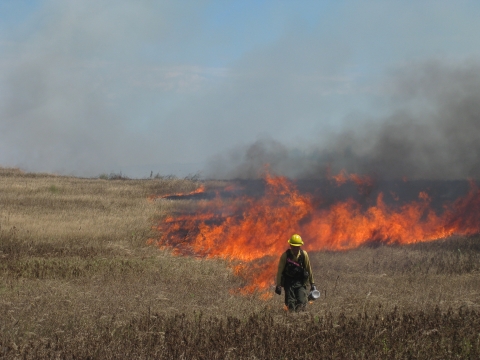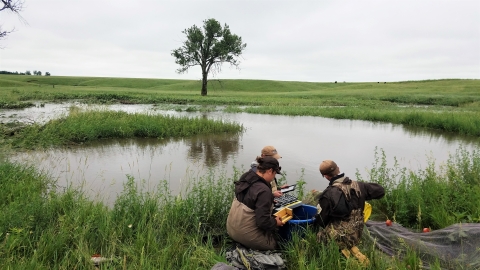What We Do
Refuges use a wide range of land management tools based on the best science available. Some refuges use prescribed fires to mimic natural fires that would have cleared old vegetation from the land helping native plants regenerate and local wildlife to thrive. Other refuges contain Wilderness areas where land is largely managed in passively. The management tools used are aimed at ensuring a balanced conservation approach where both wildlife and people will benefit. At this field station our conservation toolbox includes:
Wetland Restoration
Many of the waterfowl production areas purchased by the U.S. Fish and Wildlife Service have drained or degraded wetlands on them. District staff, often working with partners like Ducks Unlimited, Minnesota Land Trust and Pheasants Forever, then work to restore or enhance wetlands on the property to promote better waterfowl breeding habitat and seasonal stopover sites.
Water Level Management
Many larger wetlands on waterfowl production areas possess water control structures, which allow managers to raise or lower water levels. Changing water levels also changes vegetation conditions, consolidates bottom sediments and excludes invasive fish. This can improve conditions for waterfowl usage.
Grassland Restoration & Enhancement
Much of the district’s land has previously been farmed, so it is either bare soil or non-native vegetation such as smooth brome grass. Once acquired, farmland is replanted with native prairie plants. When we do a restoration, we try to re-establish what species were here pre-European settlement, to the best of our ability. We annually collect native grass and wildflower seeds from other native or pre-restored units, and then plant those seeds on the new restoration sites.
Tree Removal
By definition, native prairie generally has less than 5% to10% coverage by trees. Historically, this area was devoid of most trees except the occasional oak savanna or cottonwoods and shorter brush along rivers, streams and draws. Native prairie species evolved in this environment, and many species of grassland birds avoid nesting near trees since they serve as hunting perches for predatory birds. Our focus is to preserve prairie integrity, so we work hard to remove trees that are encroaching on our prairies.
Invasive Plant Control
Keeping invasive plants out of our prairies is a never-ending battle. If left unchecked, non-native vegetation will dominate an area and exclude native plant species. Much effort goes into managing for weeds. We try to use the least destructive control methods possible, including hand pulling, mowing or haying, or if necessary, chemical treatment with either spot spraying or broadcasting in larger areas. Chemical treatment must be done carefully, because it can harm native plants, too.
Prescribed Fire
Fire is a natural part of the ecosystem and an integral part of what naturally formed and managed the prairie. Fire burns the built-up vegetation litter, called duff, and exposes the soil to air. Fire also recycles nutrients into the soil. Many native plants evolved with fire, and their seeds won’t germinate without the heat of fire or another disturbance. Today, natural fires are often suppressed, due to safety concerns and potential damage to crops or residential infrastructure. Our fire staff plan and carry out prescribed fires on our waterfowl production areas and refuge tracts to simulate this natural ecological process. We generally burn tracts on a three to five year rotation and see significant improvements in grassland diversity and vigor, as well as a reduction in non-native plants.
Biological Surveys
District staff conduct annual breeding waterfowl surveys in spring, followed by breeding bird surveys, bumble bee surveys, and plant community surveys throughout the summer. We also support various other ongoing research studies conducted on Service lands by other organizations and research institutions such as the Minnesota Department of Natural Resources and Universities.
Easements
In addition to managing federally owned land, the U.S. Fish and Wildlife Service and the Windom Wetland Management District obtain and manage wetland and habitat easements on privately-owned property. The landowner sells certain rights to the U.S. Fish and Wildlife Service. Generally, the easements restrict draining wetlands and tilling or disturbing prairie. The landowner controls trespass and we assist with habitat restoration and improvement projects.
Private Lands Restoration Assistance
The U.S. Fish and Wildlife Service's Partners for Fish and Wildlife Program provides technical and financial assistance to solve land management problems, identify partners, and coordinate restoration work on private lands. The Partners for Fish and Wildlife Program in SW Minnesota concentrates on restoring degraded wetlands, native grasslands and riparian riparian
Definition of riparian habitat or riparian areas.
Learn more about riparian stream and river habitat habitat for migratory birds, endangered and threatened species, and fishes.
Trapping
Trapping is a wildlife management tool used on some national wildlife refuges. Trapping may be used to protect endangered and threatened species or migratory birds or to control certain wildlife populations. The U.S. Fish and Wildlife Service also views trapping as a legitimate recreational and economic activity when there are harvestable surpluses of fur-bearing mammals. Outside of Alaska, refuges that permit trapping as a recreational use may require trappers to obtain a refuge special use permit. Signs are posted on refuges where trapping occurs. Contact the refuge manager for specific regulations.
Research
Topeka shiner Cooperative Recovery
Through a Cooperative Recovery Initiative, Windom WMD staff, along with Twins Cities Ecological Services, La Crosse Fish & Wildlife Conservation Office, Minnesota Department of Natural Resources, and local SWCD's, have been working to create and restore habitat for the endangered Topeka shiner. Once covering much of the Midwest, the Topeka shiner currently exists in small, isolated populations, including areas of southwest Minnesota. Topeka shiners prefer cool, mid-sized prairie streams with access to habitat off the main channel away from predators and swift currents. Naturally occurring backwater pools include oxbows and nearby wetlands that are seasonally connected to the stream.
Topeka shiners are endangered due to habitat loss caused by changes in land-use practices. Backwater pools have become filled in with sediment from agricultural runoff. Since 2015, Windom WMD has helped create over 120 oxbows and off-channel wetlands on both public and private lands. Restoring these backwater pools involves removing several feet of sediment to increase water depth and connect to ground water, thus providing fresh water year-round.
Benefits of these habitat restorations, besides increasing available habitat for Topeka shiners, include improved water quality, recreational use, agricultural soil conservation, erosion control, floodwater storage, and additional habitat for other wildlife like amphibians and reptiles, waterfowl, and over 30 species of other fishes.
Service staff, along with area partners, continue to monitor Topeka shiner populations and off-channel habitat use in southwest Minnesota annually.
Our Services
Grazing is a win-win for the U.S. Fish and Wildlife Service and cattle producers. Not only does grazing stimulate native grasses and improve habitat, but it relieves grazing pressure off local farms. Windom WMD seeks cooperative grazers annually to help meet management needs. New grazing opportunities are usually posted in late February to early March.
Windom WMD has a very active easement and fee title acquisition program. Interested in enrolling in a grassland or wetland easement? Read more below about our grassland and wetland easement programs.
Interested in selling your property for future generations to enjoy? Contact our office! We are currently looking for new land acquisitions. Will your property be the next Waterfowl Production Area or National Wildlife Refuge?
Law Enforcement
U.S. Fish and Wildlife Service law enforcement officers have a wide variety of duties and responsibilities. Officers help visitors understand and obey wildlife protection laws. They work closely with state and local government offices to enforce federal, state and refuge hunting regulations that protect migratory birds and other game species from illegal take and preserve legitimate hunting opportunities.

